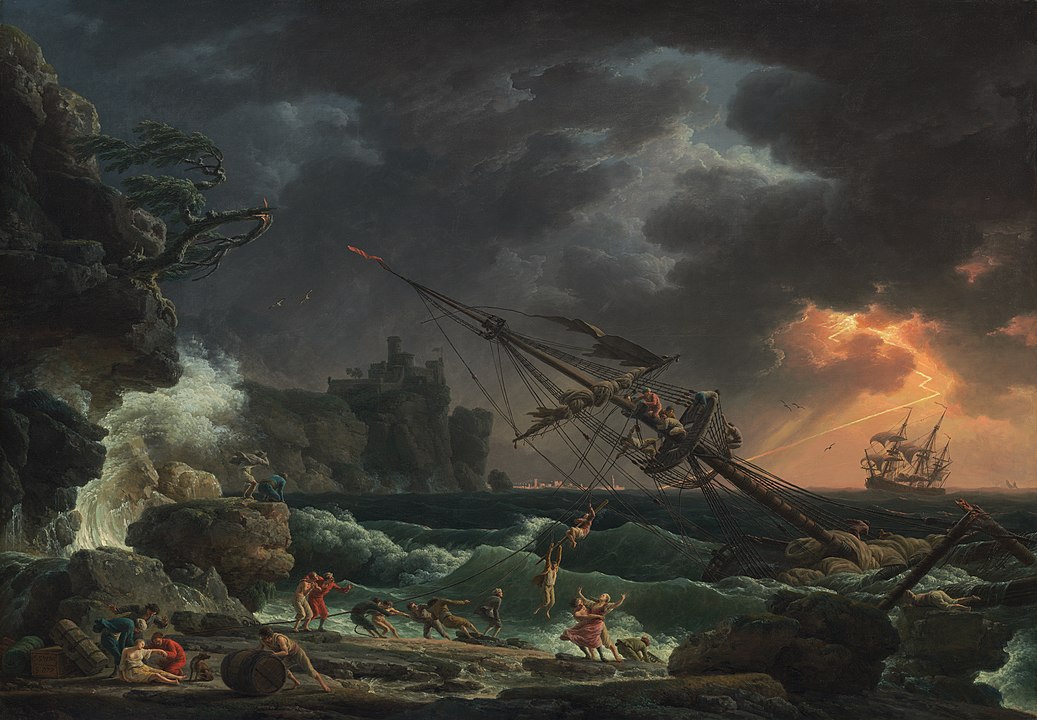
Claude Joseph Vernet: The Master of Romantic Coastal Landscapes and Harbor Scenes
Claude Joseph Vernet (1714–1789) remains one of the most admired French painters of the 18th century, celebrated worldwide for his romantic coastal landscapes, harbor scenes, and atmospheric seascapes. His masterful treatment of light, weather, and water, paired with a graceful sense of drama, elevated marine painting to poetic heights. Today, Vernet’s art continues to captivate museums, collectors, and connoisseurs of antique art. His works not only reflect technical brilliance but also embody the emotional and philosophical spirit of his age , a blend of the Enlightenment’s rational order and Romanticism’s fascination with nature’s sublime power.
This article explores Vernet’s life, his most famous artworks, the stylistic features that define his legacy, and the current value and significance of his paintings in the art market.
Early Life and Artistic Formation
Claude Joseph Vernet was born on August 14, 1714, in Avignon, France, into a family of artists. His father, Antoine Vernet, was a minor decorative painter, and it was within this creative environment that Joseph’s artistic curiosity first took root. At a young age, he showed remarkable skill in drawing and an instinctive fascination with nature , particularly the sky and the sea.
Vernet’s early talent caught the attention of local patrons, who sponsored his artistic training in Rome around 1734. This Italian journey was transformative. Rome, at the time, was the heart of European art and a magnet for young painters seeking to study the old masters. Vernet immersed himself in the works of Claude Lorrain and Salvator Rosa , two artists whose influence would permanently shape his artistic vision.
From Lorrain, Vernet learned the poetic use of light and perspective; from Rosa, he absorbed a dramatic sense of composition and the emotional intensity of natural scenes. He also studied the works of Italian Baroque painters, especially those specializing in marine and landscape subjects. Vernet soon developed his signature style: a fusion of realism, atmospheric depth, and romantic mood.
The Rise of a Master: Vernet’s Artistic Career
During his two decades in Italy, Vernet honed his craft and earned commissions from noble patrons and diplomats. His reputation grew rapidly, and his harbor scenes became sought after across Europe. These paintings were admired for their balance of natural observation and idealized beauty , they felt both authentic and dreamlike.
In 1753, after almost 20 years abroad, Vernet returned to France at the invitation of King Louis XV. The monarch was so impressed by Vernet’s marine paintings that he commissioned him to create a monumental series titled “Les Ports de France” (“The Ports of France”). This ambitious project aimed to document France’s major seaports, showcasing the nation’s maritime strength and scenic beauty. Although Vernet completed only 15 out of the 24 planned views, the series remains one of the most significant artistic achievements of 18th-century France.
Each canvas from Les Ports de France captures the unique character of a harbor , its light, atmosphere, and human activity. These works blend topographical accuracy with poetic imagination, making them both historical records and timeless works of art. The series was widely celebrated and firmly established Vernet as the preeminent marine painter of his era.
Artistic Style and Technique
Claude Joseph Vernet’s paintings are instantly recognizable for their luminous light, soft tonal transitions, and harmonious compositions. His mastery of atmosphere , the interplay between sky, sea, and land , gives his works a distinctive mood of serenity and grandeur.
1. Atmospheric Light
Vernet’s genius lies in his ability to paint light as a living presence. Whether it’s the silvery dawn over a calm bay or the golden glow of sunset filtering through storm clouds, his light effects are profoundly expressive. He captured the shifting moods of nature , from tranquil mornings to tempestuous nights , with a poetic sensibility that predates the Romantic movement.
2. Dramatic Skies and Weather
One hallmark of Vernet’s art is his dramatic depiction of weather. He portrayed clouds, storms, rain, and lightning not just as background elements, but as emotional forces that shape the human experience. His storm scenes, in particular, display a masterful command of motion and texture, with waves crashing and skies roiling in turbulent splendor.
3. Human Figures and Narrative
Unlike many landscape painters of his time, Vernet often included human figures in his compositions. Fishermen, sailors, merchants, travelers, and families populate his harbors and shorelines, bringing life and narrative to his landscapes. These figures provide a human scale to nature’s vastness, reflecting both the beauty and peril of maritime life.
4. Graceful Composition
Vernet’s compositions reveal classical balance and order. He often employed a triangular or curvilinear arrangement that guides the viewer’s eye through the scene , from the foreground’s activity to the distant horizon. This compositional harmony gives his paintings a musical rhythm, a visual symphony of light and form.
Claude Joseph Vernet’s Most Famous Artwork
Among Vernet’s many masterpieces, several stand out as defining examples of his artistry. However, one painting often rises to the top when discussing his most famous and celebrated work: “A Storm on a Mediterranean Coast” (1767), now housed in the Louvre Museum, Paris.
“A Storm on a Mediterranean Coast” (1767)
This dramatic seascape captures a violent tempest battering the shoreline. Massive waves crash against rocks, ships are wrecked in the distance, and terrified figures cling to safety amid nature’s fury. The scene embodies the sublime power of nature , vast, uncontrollable, and awe-inspiring. Vernet’s use of chiaroscuro (light and shadow) amplifies the sense of drama, as lightning flashes illuminate the chaos.
The painting is more than a mere depiction of a storm; it’s a philosophical meditation on humanity’s vulnerability in the face of nature’s might. This emotional depth, combined with technical perfection, makes A Storm on a Mediterranean Coast one of the masterpieces of 18th-century European art.
Other notable works include:
“A Calm at a Mediterranean Port” (1770) – A serene counterpoint to his storm scenes, showing peaceful maritime life at dawn.
“View of the Gulf of Naples” (1748) – A luminous panorama capturing the elegance of Italian coastal life.
“The Shipwreck” (1772) – A powerful narrative of survival and despair, revealing Vernet’s empathy and dramatic skill.
The series “Les Ports de France” (1753–1765) – The crown jewel of Vernet’s career, combining national pride with artistic brilliance.
Vernet’s Influence and Legacy
Claude Joseph Vernet profoundly influenced generations of landscape and marine painters across Europe. His son, Carle Vernet (1758–1836), and grandson Horace Vernet (1789–1863) continued the family’s artistic legacy, each achieving success in their own right.
Vernet’s combination of classical structure and romantic sentiment foreshadowed the later works of artists such as J.M.W. Turner and John Constable in England. His ability to evoke mood through light and atmosphere paved the way for 19th-century Romanticism and even influenced early Impressionist approaches to color and nature.
In France, Vernet’s paintings also played an important cultural role. Through Les Ports de France, he helped shape the visual identity of the nation’s coastal heritage , merging art, geography, and patriotism. His works were not only artistic masterpieces but also documents of national pride and progress.
The Value of Claude Joseph Vernet’s Art
Vernet’s paintings are highly prized in the global art market, sought after by museums, private collectors, and antique art enthusiasts. The value of his works depends on factors such as subject matter, size, provenance, and condition, but the demand for authentic Vernet paintings has remained strong for decades.
1. Auction Records and Market Trends
At major auction houses like Christie’s and Sotheby’s, Vernet’s large-scale seascapes regularly achieve six- and seven-figure prices. For example:
“A View of the Gulf of Naples” sold for over $3 million at auction, reflecting its exceptional condition and provenance.
“A Calm Sea with Fishermen” fetched approximately $1.8 million, demonstrating collector enthusiasm for his serene maritime compositions.
Even smaller works or studies can sell for $100,000–$300,000, depending on their authenticity and visual appeal.
The consistency of these results underscores Vernet’s enduring market stability. Unlike many artists whose values fluctuate, Vernet’s works have remained prestigious investments, often included in elite European and American collections.
2. Factors Affecting Value
Several characteristics determine the value of a Claude Joseph Vernet painting:
Subject Matter: Storms and dramatic maritime scenes tend to command higher prices than calm landscapes.
Provenance: Paintings with royal or historically significant ownership often fetch premium prices.
Size and Composition: Larger, more complex compositions are more desirable than small sketches or fragments.
Condition and Restoration: Paintings with minimal restoration or preserved original varnish are particularly valuable.
Museum Exhibition History: Works previously exhibited or referenced in academic catalogs carry additional prestige.
3. Vernet in Modern Collections
Major museums hold Vernet’s masterpieces, including:
The Louvre Museum (Paris)
The National Gallery (London)
The Prado Museum (Madrid)
The Metropolitan Museum of Art (New York)
The National Gallery of Art (Washington, D.C.)
Ownership by these world-class institutions contributes to Vernet’s sustained reputation as a cornerstone of 18th-century European painting.
Why Collectors Love Vernet
Antique art collectors are drawn to Claude Joseph Vernet’s paintings for multiple reasons:
Timeless Beauty: His compositions are aesthetically balanced, emotionally resonant, and technically flawless.
Historical Significance: His works document 18th-century maritime culture with vivid authenticity.
Investment Stability: The consistent auction performance and rarity of genuine Vernet works make them solid long-term investments.
Emotional Appeal: His paintings evoke awe, peace, and reflection , feelings that transcend time and taste.
Decorative Elegance: Vernet’s soft lighting and harmonious palettes complement both classical and modern interiors, increasing their appeal among luxury collectors.
Critical Reception and Modern Scholarship
Art historians regard Vernet as a transitional figure bridging the rationalism of the Enlightenment and the emotional depth of Romanticism. His meticulous attention to natural detail reflects the scientific curiosity of his era, while his dramatic depiction of storms and light anticipates the romantic fascination with nature’s sublime forces.
Modern scholars often compare Vernet to J.M.W. Turner, though Vernet preceded Turner by several decades. Both artists shared an obsession with light and atmosphere, yet Vernet’s works remain rooted in classical balance, offering a calmer, more meditative vision of nature.
In recent decades, exhibitions dedicated to Vernet have renewed public appreciation for his achievements. His works are increasingly studied for their technical precision, narrative complexity, and philosophical symbolism.
The Enduring Allure of Claude Joseph Vernet
Claude Joseph Vernet’s art endures as a testament to humanity’s eternal dialogue with nature. His paintings , whether depicting serene harbors or raging seas , invite viewers into a world of light, motion, and emotion. They remind us of the fragile balance between beauty and danger, order and chaos.
As a French painter celebrated for romantic coastal landscapes and harbor scenes, Vernet combined meticulous realism with poetic imagination. His atmospheric light, dramatic skies, and graceful compositions continue to attract antique art collectors worldwide. Whether displayed in royal palaces, grand museums, or private estates, Vernet’s paintings embody both historical grandeur and timeless serenity.
For collectors, scholars, and admirers of fine art, the value of Claude Joseph Vernet lies not only in the market price of his paintings but in the enduring beauty of his vision , a vision that transformed the sea into a mirror of the human soul.




